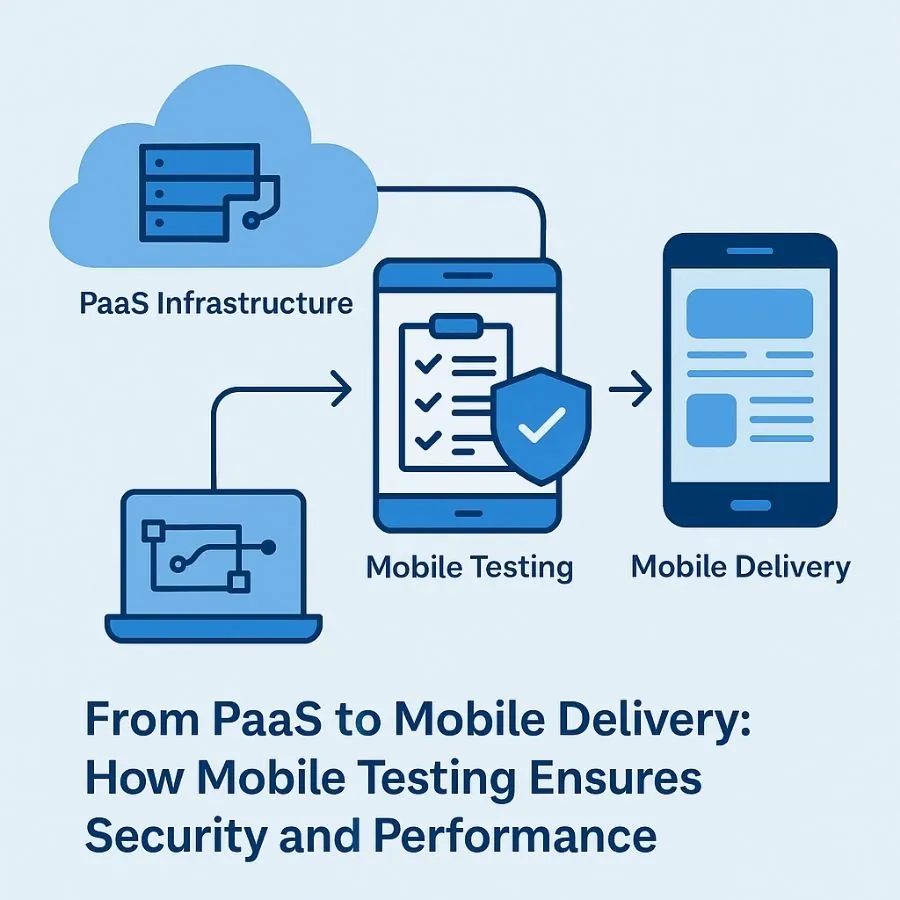In today’s digital ecosystem, software is no longer confined to a single layer of infrastructure. From Platform as a Service (PaaS) systems that form the backbone of scalable applications, to the mobile apps that deliver services directly to users, technology operates within an interconnected lifecycle. This lifecycle demands precision, security, and seamless performance at every stage.
For companies like Kogniz, which specialize in AI-driven safety, health monitoring, and workplace risk prevention, this connection is especially critical. Data travels from cloud platforms to mobile endpoints where frontline workers, security teams, and decision-makers interact with it. Any flaw in this chain, whether in backend logic, data processing, or mobile usability, can compromise both security and effectiveness.
This is where mobile testing becomes indispensable. By validating performance across devices, operating systems, and network conditions, mobile testing preserves both integrity and usability, ensuring that the apps people rely on in high-stakes environments are both secure and dependable.
The Lifecycle: From PaaS to Mobile
1. The Backbone – PaaS Infrastructure
PaaS platforms provide the foundation for application development and scalability. They handle data processing, machine learning pipelines, and API management that power real-time analytics. For example, in a Kogniz-like system, cloud platforms ingest data from sensors and cameras, then process it for mobile delivery. This stage is critical because if the PaaS layer isn’t robust, the mobile experience will inevitably suffer, regardless of how well the app itself is designed.
2. Middleware – APIs and Services
These connect backend intelligence with mobile apps. APIs serve as the translators, packaging raw data into usable insights. However, poorly tested APIs can leak data or fail under load. Mobile testing strategies must also validate API endpoints to ensure stability, consistency, and secure communication between systems.
3. The Frontline – Mobile Delivery
Finally, mobile apps deliver actionable information. Whether it’s a real-time workplace alert or a compliance report, mobile delivery requires impeccable functionality. Any lag, crash, or misinterpretation could mean a delayed response in environments where seconds matter. As mobile users operate in diverse conditions, apps must be tested under variable connectivity, device types, and operating systems to guarantee reliability.
By aligning PaaS performance with mobile testing strategies, organizations ensure that data not only flows securely but also reaches end-users in an actionable, user-friendly manner. This holistic view makes mobile testing more than a QA checkpoint; it becomes the glue that connects the entire technology lifecycle.
Why Security and Performance Go Hand-in-Hand
When dealing with sensitive environments, such as workplace safety, health monitoring, or compliance, security is inseparable from performance. An app that functions quickly but exposes sensitive data is as flawed as one that is secure but unresponsive.
Performance Risks: Latency, app crashes, or poor rendering on mobile devices can erode trust and usability. For frontline workers or decision-makers relying on real-time alerts, even a few seconds of delay can have serious consequences. Apps must therefore be optimized for stability, responsiveness, and consistency across varying conditions.
Security Risks: Vulnerabilities in API connections, insecure data storage, or flawed authentication mechanisms can expose organizations to cyber threats. In industries handling biometric or health data, such breaches are not only costly but also damaging to compliance and reputation.
Mobile testing must evaluate both aspects simultaneously, ensuring not just usability but also regulatory compliance and resilience against threats. Effective strategies simulate high-stress conditions, validate encryption methods, and confirm that security measures do not compromise user experience; delivering solutions that are both safe and seamless.
Core Aspects of Mobile Testing in the PaaS-to-Mobile Pipeline

Functional Testing
Validates that apps perform expected tasks correctly, from user logins to real-time notifications. Functional testing also ensures that each workflow behaves as intended under different conditions, including error handling, offline access, and integration with backend systems.
Compatibility Testing
Ensures apps run across varied devices, OS versions, and screen sizes. In high-stakes environments, frontline users cannot be constrained by device incompatibility. Testing must also extend to different browsers, network conditions, and regional settings to guarantee consistent performance globally.
Security Testing
Examines encryption protocols, API authentication, and data transfer processes. Given that mobile apps often handle biometric and health-related data, security testing is paramount. This includes penetration testing, vulnerability scanning, and validation of secure data storage practices to prevent breaches.
Load and Stress Testing
Simulates peak usage scenarios to confirm the system’s stability. For example, in a factory setting, hundreds of simultaneous alerts may stress the system; mobile testing helps ensure it remains responsive. Stress tests also reveal how gracefully an app recovers when it exceeds its limits.
Usability Testing
Focuses on user experience, accessibility, and navigation. A technically robust app may still fail if users cannot access critical information quickly. Usability testing incorporates accessibility standards, intuitive design checks, and feedback from real users to ensure that apps remain practical and user-friendly in demanding environments.
Example: Safety Applications
Imagine a scenario in which a mobile app notifies safety officers of a potential hazard detected by AI-enabled cameras. The backend PaaS processes the video data, runs it through detection algorithms, and sends a warning to the app.
If mobile testing is inadequate:
- The alert may not display properly on certain devices.
- Latency could delay response times.
- Insecure transmission might expose sensitive workplace data.
Robust mobile testing ensures that from detection to delivery, the chain remains unbroken, secure, and fast. It validates not only the technical flow of information but also the user experience under stressful conditions. For example, officers in the field may have limited connectivity or older devices, yet they still require instant, accurate alerts. Testing under these real-world constraints ensures the system functions reliably in unpredictable environments. By addressing security, performance, and usability together, mobile testing safeguards both the integrity of the data and the safety of the individuals depending on it.
Best Practices for Mobile Testing in PaaS-Driven Systems
- Integrate Testing Early – Embed mobile testing during development, not after deployment. By catching issues early in the lifecycle, teams save time, reduce costs, and prevent critical failures from surfacing in production. Continuous integration pipelines make early testing seamless.
- Automate Where Possible – Use AI-powered testing frameworks to simulate real-world scenarios quickly. Automation accelerates regression cycles, improves coverage, and ensures apps remain reliable even as backend services evolve.
- Test End-to-End – Don’t isolate mobile testing; ensure backend, middleware, and mobile delivery are validated together. This holistic approach confirms that data integrity and performance hold across the entire pipeline.
- Prioritize Security – Regularly audit encryption, permissions, and API gateways. Security testing should include penetration tests, secure coding checks, and compliance validation for standards like GDPR or HIPAA.
- Consider the User Context – Test under real-world conditions such as poor connectivity, device limitations, or high-traffic loads. By replicating real user environments, testing ensures mobile apps remain dependable in high-stakes or unpredictable scenarios.
The Role of AI in Mobile Testing
Just as AI enhances safety monitoring, it also revolutionizes testing. With AI-powered test automation tools like testRigor, mobile testing can:
- Generate test cases automatically from natural language commands. This eliminates the need for complex coding, empowering QA teams and even non-technical stakeholders to design meaningful tests.
- Self-heal when app interfaces change, reducing maintenance. Traditional scripts often break with every UI update, but AI dynamically adapts, ensuring continuity in fast-paced development cycles.
- Provide intelligent recommendations based on past test failures. By learning from historical data, AI predicts where problems are likely to recur and prioritizes test coverage accordingly.
This makes testing not only faster but also more adaptable to evolving systems. Beyond efficiency, AI-driven testing brings scalability, handling thousands of devices and OS combinations without exhausting human resources. It also introduces predictive capabilities, anticipating risks before they affect production. For businesses that rely on critical mobile applications, AI transforms testing into a proactive, strategic function rather than a reactive safety net. In doing so, it ensures that performance, usability, and security remain uncompromised even as applications grow more complex.
The Future of Secure Mobile Delivery
As industries increasingly adopt AI-driven monitoring systems, the importance of seamless PaaS-to-mobile integration will only grow. Future advancements may include:
- Predictive Mobile Testing – Using machine learning to forecast potential failures before they occur. By analyzing historical trends, AI can proactively identify weak points, reducing downtime and enhancing overall reliability.
- Context-Aware Testing – Tailoring test scenarios based on real user environments. For example, apps may be validated under low bandwidth, extreme temperature, or high-latency conditions to ensure functionality where it matters most.
- Zero-Trust Security Models – Incorporating rigorous mobile testing to verify every transaction, regardless of network trust levels. This approach protects against evolving cyber threats while safeguarding sensitive data streams.
Beyond these innovations, secure mobile delivery will demand greater collaboration between developers, QA engineers, and security experts. Testing will need to be continuous and integrated into DevOps pipelines, ensuring rapid yet secure deployments. As mobile ecosystems expand, the emphasis will shift from reactive troubleshooting to proactive risk management, solidifying mobile testing as a cornerstone of digital trust and operational resilience.
Conclusion
From PaaS to mobile delivery, every stage of the software lifecycle must be validated for security, scalability, and performance. Companies like Kogniz demonstrate the high stakes involved, where mobile applications are not just convenience tools but critical platforms for safety, compliance, and operational resilience.
Through comprehensive mobile testing, organizations can protect data integrity, ensure consistent usability, and deliver the reliability their users expect. As technology evolves, so too must our commitment to thorough and intelligent testing, because in mobile-driven ecosystems, performance and security are inseparable. Beyond simply preventing failures, effective testing fosters user trust, strengthens compliance with industry regulations, and drives innovation by giving teams the confidence to scale rapidly. Mobile testing becomes not just a quality assurance measure, but a strategic enabler of growth, ensuring that businesses remain competitive and resilient in a landscape where digital delivery and user expectations are constantly rising





